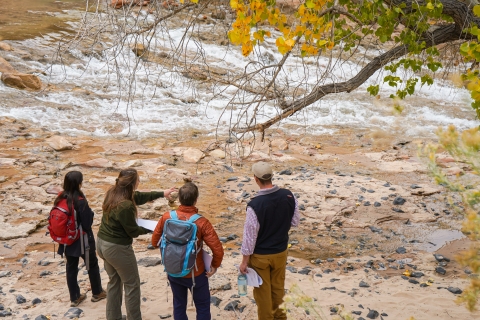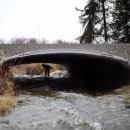States
UtahThe Four Dam Initiative will ultimately re-connect all migratory fish passage fish passage
Fish passage is the ability of fish or other aquatic species to move freely throughout their life to find food, reproduce, and complete their natural migration cycles. Millions of barriers to fish passage across the country are fragmenting habitat and leading to species declines. The U.S. Fish and Wildlife Service's National Fish Passage Program is working to reconnect watersheds to benefit both wildlife and people.
Learn more about fish passage to the upper watershed of the Virgin River system, a designated Wild and Scenic River, in collaboration with the National Park Service. This Phase 1 request is to fund final design of all four dams, construct two of the four dam removals, and install rocky ramp installations for fish passage. The Birch and Temple dams are the two most upstream dams in the river system. The structures are owned by the National Park Service and they protect a drinking water line and irrigation water supply to the Park. Birch is a 15-foot-high dam and Temple a 3-foot-high dam creating complete barriers to fish passage. Long term completion of the project will open up 20 miles of upstream habitat and providing critical habitat resilience and cold water refugia into the future. Flannelmouth Sucker (State of Utah Conservation Species), Desert Sucker (State of Utah Wildlife Species of Concern), Speckled Dace and Virgin Spinedace (State of Utah Conservation Species) are priority species that would benefit from the project. The project will provide jobs to the local economy, create outreach opportunities to communities visiting the park and enhance wildlife habitat of the river in an area of Tribal importance.
Quick Facts:
| Project Status | In Development |
| Location | UT, Washington County |
| NFPP Project Funding | $3,520,000 |
| Restoration Techniques | Dam Removal, Fish Passage Design |
| Accomplishments | 26 Stream Miles Reopened |
| Project Partner Lead | National Park Service |
| Primary Species Benefited | Flannelmouth Sucker |
The National Fish Passage Program combines technical expertise with a track record of success.
Implemented primarily through the Service's Fish and Wildlife Conservation Offices, the National Fish Passage Program provides financial and technical assistance to partners across the country. Since 1999, the program has worked with over 2,000 local communities, Tribes, and private landowners to remove or bypass over 3,400 barriers to fish passage and reopen access to over 61,000 miles of upstream habitat for fish and other animals. Staff have expertise in fish migration and biology as well as financial, engineering, and planning assistance to communities, Tribes, and landowners to help them remove barriers and restore rivers for the benefit both fish and people.
Fish passage project proposals can be initiated by any individual, organization, government, or agency. However, proposals must be submitted and completed in cooperation with a Fish and Wildlife Conservation Office. (Please note that fish passage projects being used for federal or state compensatory mitigation or required by existing federal or state regulatory programs are not eligible for funding through the National Fish Passage Program.)
CONTACT A FISH PASSAGE COORDINATOR IN YOUR AREA TO GET STARTED.




